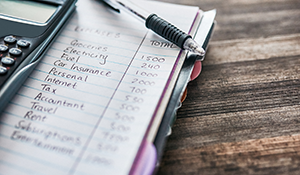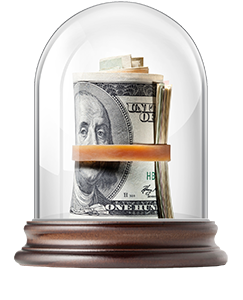 A checking account at one bank is the same as a checking account at another bank, right? Well, maybe not. In fact, according to the J.D. Power 2021 U.S. Retail Banking Satisfaction Study, now 41% of people do all their banking online. This is a pretty big shift from traditional banking.
A checking account at one bank is the same as a checking account at another bank, right? Well, maybe not. In fact, according to the J.D. Power 2021 U.S. Retail Banking Satisfaction Study, now 41% of people do all their banking online. This is a pretty big shift from traditional banking.
After reviewing the financial strength of a bank, here are several other things to consider as you decide what’s really most important to you in selecting a bank.
The online bank versus nearby location
While having a nearby brick and mortar location is important to many banking consumers, you might find better interest rates with an online-only bank because they don’t spend lots of money to maintain physical branches. As people switch to taking care of all their basic banking transactions online, one of the reasons to visit your local bank branch is to talk with a banker. If you believe you’d benefit from such discussion, make sure the online bank you’re considering will facilitate that for you.
Understand key bank fees
In addition to charging loan fees when they lend out money, banks bring in much of their revenue by charging fees on your deposit accounts. You’ll have a much more positive experience by ensuring your bank’s fees don’t outweigh the benefits of the account you’re considering. Here are three key fees to understand:
- Monthly maintenance fees. This is a monthly fee a bank charges on an account. Understand how yours works. Banks will waive these fees if your account is above a certain balance. Others waive the fees if you behave in a way they want you to behave. For instance, if you use a debit card versus writing a paper check. Others want you to make direct deposits. Still others want you to use their bill pay service. Understand this fee class and determine if you can abide by the terms your bank sets for them.
- Overdraft fees. These fees are charged to a checking account if you attempt to buy something but don’t have enough money in your account. There are a variety of ways to avoid overdraft fees, such as signing up for a protection program or linking your savings account to automatically pay the rest of the bill. Take the time to understand your bank’s options to avoid overdrafts and the cost associated with them.
- ATM fees. Some ATMs require you to pay money to use their machines, especially if the ATM you’re using isn’t in your bank’s network. Don’t overlook the opportunity to save money by ensuring that the bank you’re considering supplies ATMs in your area so you won’t have to pay a fee every time you need to use an ATM.
Other banking tools
Banks often provide tools to help you budget your daily and monthly expenses. Many offer free credit scores and credit monitoring. Others offer automatic transfers into a savings account. Still others offer the ability to open multiple savings accounts and label each account for different purposes.
Keep these tips in mind the next time you need to choose a new bank. With many different banks to choose from, a little research can ensure the bank you choose fits your financial needs and priorities.
 You may recognize the name Bitcoin and maybe even Ethereum, but what about Litecoin, Dogecoin or Ripple?
You may recognize the name Bitcoin and maybe even Ethereum, but what about Litecoin, Dogecoin or Ripple?
These are just some of the more than 4,500 cryptocurrencies available today. There are hidden tax complications, however, associated with every cryptocurrency transaction. Here’s what you need to know.
- Every transaction has a tax consequence. The IRS treats cryptocurrency as investment property, like stock, and taxes every transaction as a capital gain or loss. When you pay for something in the traditional manner with U.S. dollars, the IRS doesn’t care what the value of the dollar is at the time of the transaction. For virtual currency purposes, however, the value matters. For example, assume you buy Bitcoin for $10 and two months later the market value of that Bitcoin grows to $15 and you spend that $15 worth of Bitcoin to buy something, you’ll have a $5 taxable short-term gain that needs to be reported on your tax return. If you spend a lot of cryptocurrency, tracking the gains and losses can be very complicated.
- Big gains mean big taxes, but big losses may be limited. In classic IRS form, there is no cap on the amount of taxes you might owe in a single year for gains on the value of cryptocurrencies you sell, while losses might take many years to recoup because of the annual $3,000 loss limit against income. Adding to the complexity, virtual currencies have dramatic valuation changes…much more so than most traditional investment securities. So, you will need to budget appropriately for the taxes you’ll owe whenever you use or sell cryptocurrencies.
- Cryptocurrency puts you on the IRS’s radar. Being relatively new, virtual currency has caused the IRS to become very concerned about potential mistakes and fraud related to how cryptocurrency is reported on tax returns. The IRS is so concerned about you not reporting cryptocurrency activity that the very first question of your tax return, right beneath where you put your name and address, asks if you took part in any virtual currency transactions over the past year.
- You are responsible for bookkeeping. With the IRS watching so closely, it’s important to be accurate with your recordkeeping so you can properly report all virtual currency gains and losses on your tax return and substantiate all your transactions in the event of an audit.
Tax and financial planning is a year-round proposition. In fact, you can benefit personally from a continuous, 12-month rolling forecast, much like a business does.
What is a rolling forecast?
Rolling forecasts let you continuously plan with a constant number of periods 12 months into the future. For example, on January 1, you would plan what your financial picture looks like each month through January 1 of the following year. When February 1 rolls around, you would then drop the beginning month and add a forecast month at the end of the 12-month period. In this case, you add February of the next year into your 12-month forecast.
 The month you add at the end of the 12 months uses the finished month as a starting point. You then make adjustments based on what you think might happen one year from now. For example, if you know you are going to get a raise at the end of the year, your next-year February forecast would reflect this change.
The month you add at the end of the 12 months uses the finished month as a starting point. You then make adjustments based on what you think might happen one year from now. For example, if you know you are going to get a raise at the end of the year, your next-year February forecast would reflect this change.
How to take advantage of a rolling forecast
By doing tax and financial planning in rolling 12-month increments, you may find yourself in position to cash in on tax- and money-saving opportunities within the next 12 months. Here are several strategies to consider:
- Plan your personal budget. Will you need to put a new roof on your house? How about getting a new vehicle? Do you need to start saving for your kids’ college education? A rolling 12-month forecast can help you plan for these expenses throughout the year.
- Plan your healthcare expenses. If you have a flexible spending account (FSA) for healthcare or dependent care expenses, forecast the amount you should contribute for the calendar year. Although unused FSA amounts are normally forfeited at year-end, your employer may permit a 12-month grace period (up from 2½ months) for 2021. This means that you could potentially roll over your entire unused FSA balance from 2021 to 2022. Your forecast can help you see the impact of this change.
- Plan your contributions to a Health Savings Account (HSA). When an HSA is paired with a high-deductible health insurance plan, you can take distributions to pay qualified healthcare expenses without owing any tax on the payouts. For 2021, the contribution limit is $3,600 for an individual and $7,200 for family coverage. In this case, you can forecast an increase in contributions and double-check to ensure you have enough money on hand to pay future bills.
- Plan your estimated tax payments. This is often significant for self-employed individuals and retirees with investment earnings. The quarterly due dates for paying federal and state tax liabilities are April 15, June 15, September 15, and January 15 of the following year (or the next business day if the deadline falls on a holiday or weekend). So, if your personal income is seeing a recovery from the pandemic, your rolling forecast will show this and allow you to plan for the estimated tax payments.
- Plan your retirement contributions. If you participate in your company’s 401(k) plan, you can defer up to $19,500 to your account in 2021 ($26,000 if you’re 50 or over). Contributions and earnings compound tax-deferred. As the year winds down, you might boost your deferral to save even more for retirement.
While initially setting up a rolling 12-month forecast can be a bit of a pain, once established, it is pretty easy to keep up-to-date as you are simply rolling forward last month into the future. A well-planned system can often be the first sign of future challenges or potential windfalls!
Paying bills is an inevitable part of everyday life, but that doesn’t mean it has to be stressful. Here are some ways to get control of your budget and perfect the art of stress-free bill paying.
- Make a budget. Knowing what you are making and what you are spending is essential to proper bill paying. First, find out how much you are making every month and then subtract the static items such as rent or mortgage payments, credit card payments and cell phone expenses. Then, budget out how much you will need for other essentials (such as food and clothing). Once the essentials are accounted for, you can look at the money you have left and decide where to allocate the rest.
- Find a budget tool that works. One of the best ways to get a handle on your finances is to use a budgeting app such as Intuit’s Mint or PocketGuard. You can securely link your bank accounts to these apps and download all your transactions in the app. Your bank may also have an app to track your spending, so also check with them. You can then choose which tools to use to make a budget and categorize the transactions to be allocated to a certain part of the budget (such as food, car, housing, etc.).
- Set up autopay. Put recurring bills such as utilities, internet, and your cell phone on autopay so they will be automatically deducted from your account on their due date. If you decide to use autopay, it is still a good idea to look at the amounts being deducted every month to make sure everything is correct.
- Consider your non-regular payments. Don’t forget to account for bills that come due occasionally and plan for the cash outlay. Common examples of this are property tax payments, income taxes, and annual/semi-annual insurance payments. You will need to plan to have enough cash on hand for these expenses when they come due.
- Adjust due dates. Paying bills isn’t as stressful when you know that you can afford to pay them, and what better time to pay bills than right after you get paid! The money will be there and you can pay those bills before that money has a chance to go anywhere else. Consider asking if you can change the due dates for some or all of your bills to correspond with when your paychecks are deposited into your bank account.
- Don’t forget to pay yourself! One of the best ways to start developing a savings account is making yourself part of your budget! Take however much you think you can spare and set up an automatic transfer to a separate savings account. Use this money to establish an emergency fund of approximately six to nine months of expenses. This extra cushion will come in handy if something unexpected occurs.
Which unique method of budgeting will work for you?
 You have your own unique personality, preferences and lifestyle. Likewise, how you manage and organize your finances can have its own personality, including how you budget. Here are five different methods of budgeting, each with a distinct way of helping you organize your spending and finances.
You have your own unique personality, preferences and lifestyle. Likewise, how you manage and organize your finances can have its own personality, including how you budget. Here are five different methods of budgeting, each with a distinct way of helping you organize your spending and finances.
- Traditional budget. Use last year’s budget as a base, make any necessary adjustments due to changes in your income or expenses, and create your budget by taking your income minus your expenses to equal the amount you have to spend.
- Envelope budget. Keep a set amount of cash for the month in envelopes labeled with an expense category like groceries, clothing, eating out, entertainment, etc. Use one envelope per expense category. If you run out of money in one envelope, you can dip into other envelopes, but this will obviously impact spending in those areas.
- Reverse budget. Instead of stashing away the money left over after you’re done spending for the month, first take out your portion for savings and then spend the amount of money that remains. Reverse budgeting is an effective way to prioritize saving for your future retirement, an emergency or rainy-day fund, or other big expenses like a vacation, a new car, or a down payment on a house.
- Zero-based budget. Know where each dollar is going and record every single dollar spent. Also called the zero-sum or down-to-the-dollar budget, this method helps you get specific about spending and keeping track of all your dollars. Instead of one amount allotted for food, you know exactly how much you will spend on groceries, lunch while at work, and dining out. Instead of one amount allotted for savings, you know exactly how much you are putting into retirement, loan repayment, and emergency savings.
- 50/20/30 budget. Stick to three spending categories. Each month, 50% of your take-home income goes toward needs, 20% toward savings, and 30% toward wants. Examples of needs are housing or car payments and groceries. Savings could be retirement money, paying off loans, and emergency funds. Wants include things like shopping, vacation, or entertainment. Less detailed than the zero-based or envelope methods but more detailed than traditional or reverse budgeting, the 50/20/30 method helps you monitor money habits by helping you stick to three categories every month.
The best budget approach? One that works for you and one that you will continue to use. So pick an approach and try it. It can really change how you spend your money.
As always, should you have any questions or concerns regarding your tax situation please feel free to call.
A sad and oft-repeated truth is that half of all new businesses fail within the first five years. Although many factors contribute to business failure, a common culprit is poor cash management. All businesses, large and small, must deal with the uncertainty of fluctuating sales, inventories and expenses. Follow these practices to moderate the ebb and flow of cash in your business:
Analyze cash flow. If you don’t know it’s broken, you can’t fix it. The starting point for any meaningful action to control cash is discovering where the money’s coming from and where it’s going. Get a handle on cash by monitoring your bank accounts for at least one complete business cycle; then use that information to establish a realistic forecast. This should be done throughout the year to help you understand your seasonal cash needs.
 Monitor receivables. Extending credit to risky customers, failing to identify late payers, refusing to collect payment on a timely basis — these practices amplify cash flow problems. Mitigate receivable fluctuations by generating aging reports. Use the report to follow up when payments are late. You may even wish to offer discounts to customers who pay early.
Monitor receivables. Extending credit to risky customers, failing to identify late payers, refusing to collect payment on a timely basis — these practices amplify cash flow problems. Mitigate receivable fluctuations by generating aging reports. Use the report to follow up when payments are late. You may even wish to offer discounts to customers who pay early.
Slow down payments. Prudent cash flow management dictates that you retain cash as long as possible. So pay your vendors on time — not too early. Of course, if suppliers offer discounts for early payment, take advantage of cost savings whenever possible. Also consider negotiating with suppliers to extend payment terms.
Time large expenses. If you know a property tax payment is due in May, start setting aside money in a separate fund in October. The same holds true for any large payment that comes due during the year. If your equipment is nearing the end of its useful life or your roof is showing signs of wear, start saving now. Don’t let big expenditures catch you by surprise.
By taking these steps and endeavoring to smooth out cash fluctuations, proficient managers keep their companies strong throughout the business cycle.
 According to the Federal Reserve, U.S. student loan debt is now $1.5 trillion with more than 44 million borrowers. Only mortgage debt currently has bigger numbers among types of consumer debt. Even worse, more than 10 percent of these loans are past due. Here are some tactics to help make student debt easier to manage:
According to the Federal Reserve, U.S. student loan debt is now $1.5 trillion with more than 44 million borrowers. Only mortgage debt currently has bigger numbers among types of consumer debt. Even worse, more than 10 percent of these loans are past due. Here are some tactics to help make student debt easier to manage:
- Know the loan terms. Not all student debt is created equal. Understanding the terms of all your student loans is important. With this knowledge, select the correct loan option and know which loan to pay first. Things you should know about each loan include:
- The interest rate
- The term of the loan
- Amount of any upfront fees
- Pre-payment penalties (if any)
- When interest and payments start
- Payment amounts
- Payment flexibility
- How the interest is calculated
Suggestion: Create a spreadsheet with a student loan in each column. Then note the terms under each loan. This will create a strong visual of your situation and show you which loans are most important.
- Avoid accruing interest. Some student loans accrue interest while you are in school. With the compounding of this interest, your student loan amount continues to grow with each passing year before repayment begins. Banks love this — you should not.
Suggestion: Figure out how to make some or all of the interest payments while in school. This will not only lock the amount you owe, it will reduce the amount of overall loan payments.
- Pay a little extra in the early days. The math of loans benefits banks in the early years of the repayment period. This is because the vast majority of interest is paid in the first years of repayment. By the time you get to the last year of repayment, payments are primarily the principal balance and interest is nil.
Suggestion: Pay extra every month as soon as payments start. While this seems impossible as you enter the workforce, even $25 extra per month can dramatically reduce the amount of total payments you make over the life of your loan. For example, a $25 extra payment on a 10-year $50,000 student loan with 5 percent interest would cut six months off the loan, save $834 in interest, AND save $3,180 in future loan payments!
- Make small cuts elsewhere. Having a hard time finding a few extra dollars to make extra payments? Consider observing and then changing your spending habits.
Suggestion: Purchase one less latte a week. Drop one monthly service from a bill. Eat in more often. Then use these savings as a bonus payment on your student loan principal.
While student debt is often an unavoidable outcome of getting a college education, it can be minimized if actively managed. Small changes can yield results if planned for in advance.
If you’ve ever attended a state or county fair, you know it’s really easy to spend a lot of money, and fast. The best way to avoid overspending is to know the problem areas and be prepared. Here are five typical fair spending traps (and tips to avoid them):
 Paying full price for admission. In 2019, the price of admission for a state fair can cost a family of four well over $50. Most fairs offer pre-sale discounts or set aside days with special rates. Some examples include half-price admission days, opening day, closing day or certain days during the week. In addition to admissions discounts, you can often find discounted ride tickets or coupons for food or attractions before the day you head to the fair.
Paying full price for admission. In 2019, the price of admission for a state fair can cost a family of four well over $50. Most fairs offer pre-sale discounts or set aside days with special rates. Some examples include half-price admission days, opening day, closing day or certain days during the week. In addition to admissions discounts, you can often find discounted ride tickets or coupons for food or attractions before the day you head to the fair.
Not having a food strategy. Do you really need that whole deep-fried onion? Or entire bucket of fries? If you go to the fair with some friends, opt for the small portion, wide variety strategy. Take turns buying the goodies and share. It’s a perfect way to try new things without overindulging! Your budget (and digestive system) will thank you later.
Impulse buying. While it’s really cool that the blender can turn a bushel of apples into a smoothie in six seconds, it doesn’t mean it’s worth $300. There are a lot of fun and unique products to buy at the fair, but have a plan. If you will be doing some shopping, identify your needs and create a spending budget prior to taking in the product demonstrations.
Ignoring the weather. All it takes is a pop-up thunderstorm or unexpected heat wave and you can watch the prices on ponchos and bottled water shoot up faster than Old Faithful at Yellowstone National Park. Before you go, check the weather, bring appropriate gear and empty water bottles to fill at free water stations.
Falling for carnival gimmicks. All you need to do is make one of three basketball shots to win that huge pink gorilla. Don’t fall for it. Chances are the rim is one foot higher, two inches narrower and the ball might even be egg-shaped. Go ahead and give it a try for fun — just try not to get frustrated if you don’t hit the shot. Carnival games can be a good time if you have the right mindset. Treat them as entertainment, not a way to easily win a valuable prize.
Fairs are a great way to spend a late summer or fall day and make some memories. Saving some cash with some savvy decisions makes it even better!
Most everyone knows you need to budget, balance and save. However, here’s a list of the ten steps to ensure you walk on stable financial ground.
- Set a budget and stick to it – Make financial goals and then create a budget that supports those goals. Account for expenses on a monthly basis and set budget limits for dinner out and other forms of entertainment.
- Pay off all debt (except a home mortgage) – Make debt payments a part of your budget until paid off.
- Set aside money for future expenses – Plan in advance for both short- and long-term big expenses and create a line item for them in your monthly budget.
- Save for emergencies – Set aside funds each month to build a reserve of three months living expenses (eventually build up to six) to guard against job loss or unexpected expenses. Having these savings automatically deducted you’re your income makes it easier.
- Take advantage of available plans – Company-sponsored 401(k) plans and/or other retirement plans, 529 savings plans and education funds will help you financially later. A little put away today can mean a lot is available tomorrow.
- Spend only what you have – Limit uses of credit vehicles like credit cards and high interest cash advances. Pay off credit cards by due dates each month.
- Manage your financial life – Regularly manage and monitor your accounts and statements, including balancing your debit/checking account and investment accounts.
- Keep an eye on your credit score – Making timely payments is one of the best ways to maintain good credit for future lending. If used responsibly, automatic payment systems like online banking can be beneficial.
- Set up Identity Theft Protection on your financial accounts – Regularly change your online and mobile passwords, and safeguard your financial statements.
- Openly communicate with your spouse about your family’s financial position – Make sure you both agree on short- and long-term goals. Teach your children the power of saving and budgeting to put them on the path to a successful financial future.
Last week we gave you the first half of a list of essential economic concepts that every high school student should understand. Here’s the second half of the list!
The strength of investing – The most valuable investment a young person can make is in themselves. Whether it is a college degree or a trade school diploma, your child can create tremendous value in skills that will provide a positive financial return each year.
Mutual fund and stock understanding – Once your child grasps self-investment, next consider teaching some of the basic investment alternatives available to them. Stocks and mutual funds are the most common, but also consider explaining bonds, CD’s, annuities and other investment tools.
Budgeting – Help your student create a basic budget and then help them track their saving and spending against the budget. Don’t forget to mention an emergency fund to prepare for the surprises in life.
Cash flow – The hard way to learn the lesson of cash flow is when bill collectors are calling and there simply isn’t money to pay them. When creating an initial budget, show your child the flow of funds each month. An easy example of this is to show the flow of funds that relate to car. There are everyday expenses like fuel, there are monthly expenses like a car payment or insurance, and there are periodic expenses for licensing and maintenance.
Calculation of net worth – Assets (what you own) minus liabilities (what you owe others) equals net worth. This is the math of banks and businesses. The sooner your child understands this concept, the easier it will be to plan to purchase a car, a house, or any other item of value.
The value of identity – The value of a personal identity is the most undervalued asset owned by your child. Online media may seem free, but your child has paid for this access with their identity. With the advent of identity theft, government/employer access to personal online information and the proliferation of online advertising, consider helping your child understand the value of having a small online footprint. Help them establish healthy habits that will protect their personal information.
I hope you find this information helpful in preparing your child for a sound financial future.